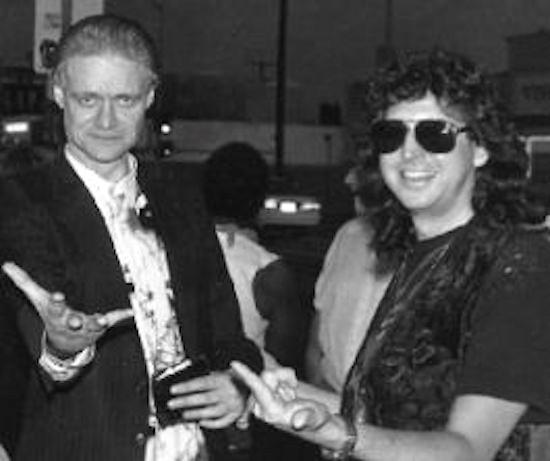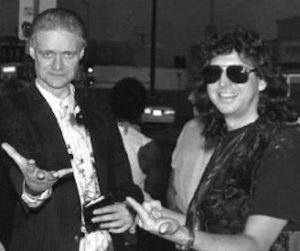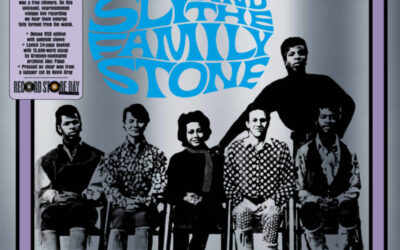Kim Fowley is a gas. I was his friend and worked on a whole bunch of music projects with him. He had wit and wisdom of survival, and vision in the music business.
I was listening to his Outlaw Superman album late at night recently and just started cracking up, because Kim was always having fun in the studio as a solo artist.
His vast knowledge as an all around producer and business liaison helped many budding recording artists and bands achieve dreams and success.
I asked Cave Hollywood contributor, author and music historian Harvey Kubernik, to go into his vast literary archives and display something cool on Kim.
This 2007 interview Harvey conducted with Kim reveals unique observations on the fabled 1967 “Summer Of Love” and groovy reflections on the vibrant music, personalities as well as important bands from that cosmic era.
David Kessel
CEO Cave Hollywood
Kim Fowley on the 1967 Summer of Love
By Harvey Kubernik C 2008
Q: What were you doing in 1967?
A: I was the MC all year at the Love-Ins held every weekend in Los Angeles at Elysian Fields near downtown L.A. I was also working with bands locally.
Q: What did the Summer of Love achieve?
A: “Summer of Love achieved a lot because at the time, everything was possible from a youth perspective. Stopping the Vietnam War was possible. Getting laid was possible. Reinventing yourself was possible. Doing it without materialism, doing it without a college degree, doing it without mom and dad making you a lawyer or doctor. There was possibility of a Utopian brave new world. You had Doors, Love locally, and Pink Floyd doing things in England. And you had people who continued like Lovin’ Spoonful and the Byrds.
“The standard of music was amazing and everyone was under 30 years of age.
FM radio became more prominent with play lists broadcasting albums instead of singles that AM stations programmed. There was a window, through 1967, where Peanut Butter Conspiracy was on play lists with the Beatles. But, there were so many bands and the brain can not comprehend and absorb it all, and if you were 16 years old then, you didn’t have money to buy thousands of records ever week. So, a lot of people just got lost in the shuffle that were wonderful.
“Radio formats, until the beginning of FM radio would play anything good. Then FM radio came along and messed it up. The same way “Downbeat” magazine messed up jazz. The critics showed up. And, a bit later in 1968, “Rolling Stone” magazine showed up and all of a sudden had to put an intellectual meaning and enforce a culture on something that was supposed to be wild, crazy, fun and illuminating. And the missionaries then showed up, along with FM radio, lyrics sheets, critics, censorship and structure, and when you harness a wild animal it becomes domesticated and horrible. And, that’s the downside of 1967.
“I was a DJ on KPPC-FM, the Pasadena-based “hip” radio station in 1967 for one weekend but got fired because I played an Otis Redding campaign song for 1968 Democratic Presidential candidate Hubert Humphrey. It was the “Hucklebuck” with Hubert Humphrey lyrics. I also played Country Joe and The Fish’s “Fixing To Die Rag” right afterwards, back to back. And they fired me on the spot. I then gave the address of the station over the airwaves, and a 1,000 kids showed up in the parking lot to party. Before then, in 1960, I was west coast promotion man for Barry Gordy, Jr. and Motown.
Q: What about Jimi Hendrix who was heard in 1967 in North America.
A: Summer of Love 1967 didn’t expose me to Jimi Hendrix the first time. In 1966 I produced the Soft Machine previously in England, who like Jimi Hendrix, were managed by Michael Jeffreys, who also had the Animals at the time. In 1966 I was his neighbor in England in Bayswater. In our first 45 minute meeting in the hotel lobby, I was literally the first person he met when he got off the plane from New York, we talked music, and he said he wanted to play science-fiction rock ‘roll. In 1966 or early ’67, I was the one who told Warner/Reprise label head Mo Ostin about Jimi and that it would be a good idea to sign Hendrix to the label for North America. An hour later Brian Jones and Jack Nitzsche visited him in Burbank and confirmed what I said.
“We all knew that Jimi would be great acquisition for the label in America. I knew Jimi would take over in summer 1967 in America because he had chitlin circuit experience, and he knew how to work a crowd in the chicken wire chitlin’ world. He was an experienced performer and everyone else were suburban white kids trying to be English or black. Jimi liked the fact that I knew about the Spanish Castle venue in the Seattle area. I was the promo man for “Tall Cool One” by the Wailers from his neighborhood, since I was tall and cool, and I was a producer of L.A. based Richard Berry, who wrote “Louie, Louie,” who wrote “Half Love Will Travel” that were regional hits, and Jimi knew them.
Q: You knew Big Brother & the Holding Company.
A: I was almost in Big Brother & The Holding Company. The band heard my record “The Trip,” and thought I had the goods. But I wasn’t interested in living in San Francisco, which was damp and foggy. Chet Helms had brought Janis up from Venice, and she auditioned and got the job. She was tremendous. Janis was a chameleon who was a homely girl off stage but a goddess and a sensual animal on stage as soon as she opened her mouth and started prowling the stage. It was that beauty from within thing that made it happen for her. She spent a lot of time listening to Etta James, Bessie Smith and Big Mama Thornton.
“The Summer of Love also didn’t expose me to the Who, either. I knew Keith Moon from 1964 when he was in the High Numbers, and met them all. In 1966 I met him again when Bruce Johnston and I conspired with him to bring john Lennon and Paul McCartney down to the hotel room in England to have an advance listen to the disc of “Pet Sounds.” Pete Townshend was a guy who said write long songs in various parts so you can take away, as opposed to writing a short song and add to it. And songwriting is everybody’s pension in the future.
“The music birthed at the Summer of Love endures. The Kaleidoscope used music from other cultures and centuries to illuminate the psychedelic midnight. There was even one recording they did, sometime in 1967, where world beat meets cosmic R&B on tape. Kaleidoscope cut with Larry Williams and Johnny “Guitar” Watson! “Nobody” that Three Dog Night eventually covered and scored with. These are the sort “experiments” and events that emerged in and around the Summer of Love in Hollywood.
Q: What about the Doors?
A: The Doors, partially because John Densmore was a jazz drummer. You also had a jazz keyboardist and a jazz guitarist all playing the blues with a real great poet and actor fronting it. It was tremendous. It was theater. Jim Morrison was the best white in person performer. Better than Elvis. Better than Jagger. Because he did what Howlin’ Wolf and Lawrence Olivier did. He did it all at the same time. He did William Shakespeare and gut bucket together. And only PJ Proby rivaled him and David Bowie came in third.
“Jim could sing in pitch, he had the image and the poetry. He understood theater. Manzarek supplied a pulse, and Robby the guitarist is never given the credit what he brought to the table in 1967. The Doors were not a rock ‘n’ roll band but gave you a rock ‘n’ roll feeling. And the only band that did that was the original King Crimson. ‘Cause they weren’t a rock ‘n’ roll band, either, but when you heard “Court of the Crimson King,” and Pink Floyd ’67, they were the only bands who had some Wagner with a rock ‘n’ roll attitude.
“I loved Marty Balin in the Jefferson Airplane. He was the soul of the band. Examine the recordings they did over 1967, and the songs he wrote then. Country Joe and the Fish…They were tremendous live. He was a lot like Jim Morrison with an acoustic guitar. They almost could have been cousins. He had the similar control of an audience like Morrison had. Only Joe did it on a folk level, banging on his “Woody Guthrie” type guitar. I used to see the Chambers Brothers gig. They would tear up a place, and then Joe and his band would come in and blow them off.
Q: And the Beatles in 1967 and Sgt. Pepper’s
A: George Martin was the catalyst for the embryonic dreams of Lennon, McCartney, Starkey and Harrison. Martin was able to consolidate and expand their anticipation. He was a great editor. Ringo was smarter than you think. Lennon nicer than you would think.
Paul McCartney, Steven Tyler off stage. Harrison invisible when he needed to be. They had magic because of the Irish blood that flowed in the veins of Lennon and McCartney. It was the Irish refugee coming across the Irish Sea from Ireland and having children and settling into Liverpool, as a seaport city with an Irish background. Ireland has this tremendous music culture. The most musical nation on earth. I’m Irish by the way and I get to say that. I’m an Irish citizen.
“You put that Irish sense of melody and then you put the black music with Chet Atkins and Eddie Cochran and you stir it all up and the isolation of Liverpool, that North of Watford situation, where everyone in the South of England thinks they’re so sensitive and so brilliant, but all the soul of England is north pf of Watford, especially in the northern part with Liverpool. I always believed the northern artist more than the southern artist in England. That’s the difference between the Stones and the Beatles. The Beatles were from the north, and the Stones from the South.
Q: And the Stones coming out of 1966 and through 1967.
A: There’s magic in the Stones, too. Keith had the great pulse. And Mick was the great derivative interpreter of the attitude and juke vibe. And those two guys had the great rhythm section with Watts and Wyman. The other guitar players were interchangeable.
Brian Jones was a friend of mine and the one I knew the best in the band. I met him at parties in California and saw him at RCA studios when the group was recording 1964-1966 in Hollywood. His ex-girlfriend, Linda, who later married Donovan, was a friend of mine. I knew her in L.A. and Hollywood. We’d hang out together.
“Brian Jones was a lot like George Martin. He was a strategist musically. He was the best musician of the Stones, granted the rawness of the pulse came from Keith, and Mick did the vocal extension. Brian provided the taste, with Watts and Wyman. Brian was like Charlie Chaplin before him. Brian could pick up any instrument and play it immediately. He was a musicologist. He was a pretty boy with George Martin’s brain with stringed instruments. He probably was too smart and too gifted and it exploded. He couldn’t contain the greatness in a daily life level.
“Summer of Love 1967, Brian might have been the musician of the period. His work on “Satanic,” coloring, not songwriting, along with his wardrobe. Charlie Watts wished he was Charlie Yardbird Parker’s drummer, Bill Wyman turned out to be the Valentino of the group. Keith the soul of the band and the reason they’re still there. Keith plays the way Steve Cropper and Mars Bonfire play. He plays rhythm guitar on a Chess Records and Buddy Guy level. Keith understands what to leave out. Slim Harpo. Mick Jagger is the business glue that holds it together now but at the time earlier, was a great front man, and still is, and a great navigator. And was able to get the little girls going between art and commerce.
“Andrew Loog Oldham in 1966 and way through the 1967 Summer Of Love owes a big debt of gratitude to Lou Adler, who earlier gave him access to the Laurel Canyon and Sunset Blvd. culture. I know they met in 1964 formally in Santa Monica, and Adler connections like Guy Webster took the photos in the Stones High Tide And Green Grass package. In 1967, Flowers was released that
“So, Hollywood, circa 1967 informed not only the music the Stones recorded 1964-1966, and perhaps a bit in 1967, but certainly product artwork of the period. So Andrew was able to give Mick and Keith a California schtick as well which they incorporated as they were evolving. Andrew realized they could only recycle Excello Records and Chess Records so long.
“Andrew Loog Oldham was brilliant. Like Robert Plant, he was a record collector on top of everything around him. Immediate Records was very indicative for the time period. ALO was an eccentric guy setting up a heaven and a consistency for eccentric artists who did cross over. And it was innovative. The Nice, Small Faces. P.P. Arnold. Andrew wore Suddenly Last Summer white suits. In 1964, ’65, when he walked into a room with Marianne Faithfull the room stopped. He was 20 going on 50.
Q: Tell me about soul music in 1967
A: Motown was based on the Detroit Auto assembly line. It’s based on the sound of building cars and fenders. It has to be loud because it’s a loud city. Stax is Mississippi River and laid back. The Stax tour of 1967 in England and Europe galvanized those people because black people invented rock ‘n’ roll. Even the white people playing with black people had black souls. And blues, jazz, country, gospel and various combinations equals rock ‘n’ roll. Remember: Rock and roll is a by-product of a four way sex orgy between blues, jazz, gospel and some folk/country.
“Some psychedelic summer music 1967 was sped up black rip offs where white people had drugs. Otis Redding was like Bono. His wife Zelma told me Otis made up spontaneous songs. Booker T. Jones was like Keith Richards and Leon Russell: He knew what to leave out. Black music is what you leave out. You can catch your listener in the holes that you allow and everyone falls into, like a warm womb. But there was some white, psych music of 1967, Small Faces, Traffic especially, which did this. Producer Guy Stevens was very important in the music heard in clubs in 1967. He put out my record “The Trip” in 1966 for Island Records. He was a black music aficionado and went with psychedelic music as a marketing ploy. His passion was black music.
“Motown started opening up as Norman Whitfield and others involved with the label began hearing FM underground progressive radio. But, I know what kind of impact the spring 1967 Stax/Vault tour of England and Europe had not just on the audiences but on the musicians, and the wannabee musicians who caught it as well. This was a month before Otis Redding and Booker T. and the MG’s performed at Monterey. In England and France Otis was huge before he blew minds at Monterey Pop.
Portions of this text ran in a 2008 issue of MOJO Magazine.







